
The federal minimum wage hasn’t gone up in nearly 10 years. Yet with a stroke of his pen, Jeff Bezos of Amazon raised the wages of hundreds of thousands of the company’s lowest paid workers recently. [These wage increases were funded, at least in part, by stripping away some non-wage benefits from some of Amazon’s workforce.]
In an age of extreme income inequality, this is a leap in the right direction. It’s also a stark reminder of how far we as a nation are from caring for our most vulnerable people.
Consider the story of Vanessa Solivan, an East Trenton, N.J. mother of three struggling in and out of homelessness. Vanessa is “working homeless,” an increasingly common phenomenon as the gap between wages and cost of living grows wider.
In the richest country in the world, millions of families shouldn’t have to struggle every day to get by while wealth concentrates into fewer and fewer hands at the top.
Workers’ fates shouldn’t be at the whims of billionaire CEOs—that’s why the minimum wage was introduced in the first place. Yet today’s federal minimum wage of $7.25 is less than the cost of living of every major city in the country.
Vanessa shared her story with Matthew Desmond in a recent New York Times feature story titled, “Americans Want to Believe Jobs Are the Solution to Poverty. They’re Not.” Desmond, author of the Pulitzer Prize winning book Evicted, and a Princeton sociologist, shows that working is no longer an antidote to poverty.
Vanessa holds down a job as a home health care aid for 20-30 hours a week while juggling her parenting and childcare duties, and also managing her own health. For her efforts, Vanessa earns about $1,200 in a good month. Last year, she made just $10,446.81.
Desmond relays Vanessa’s constant struggle to feed, clothe, and house her family, navigating the byzantine patchwork of public programs designed to help her, but not too much.
Despite tax credits that increased her income by $5,000, she remained well below the poverty line. And when she did find herself with a little more money than usual, like when her daughter qualified for Social Security Disability Insurance, other cuts were often made—in that case, her Supplemental Nutrition Assistance Program funds were slashed.
Vanessa’s story is far from unique. The average income for the bottom half of wage earners is just $16,000, according to economist Thomas Piketty.
Despite major increases in productivity, the buying power of average hourly wages hasn’t gone up in four decades. Meanwhile, rents continue ticking upward, and more Americans join the ranks of the “working homeless.”
Given such poverty, one might logically assume the United States is poor. Quite the contrary. If we split the nation’s combined wealth equally among households, the country has enough money for every family to have nearly $800,000.
So where’s all that money?
Consider Bezos, the founder of Amazon. He’s the wealthiest person in the world, with a net worth around $165 billion. For context, that means he has enough money to spend $20 every second, every day—for the next 261 years.
One way Bezos got so rich is that until recently, he paid his workers the lowest rate he could legally get away with. He left many to depend on public assistance programs for food, housing, and other essentials. So too did the Waltons of Walmart, who also built their riches on the backs of low-wage workers.
If companies pay workers less than it costs those workers to live, it’s their billionaire owners who benefit the most from government subsidies. Why on earth would we subsidize billionaires in an age of extreme inequality?
The time is past due to end poverty. Dramatically raising the minimum wage is just one step. Also needed are a host of other interventions to help all of us live dignified lives.
As Desmond points out, it’s no longer enough to say any “Nobody who works should be poor.” Nobody in America should be poor, period.
OtherWords / Institute for Policy Studies










